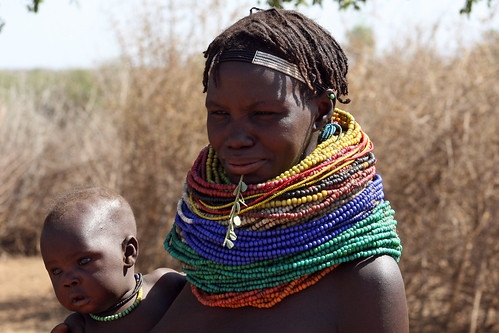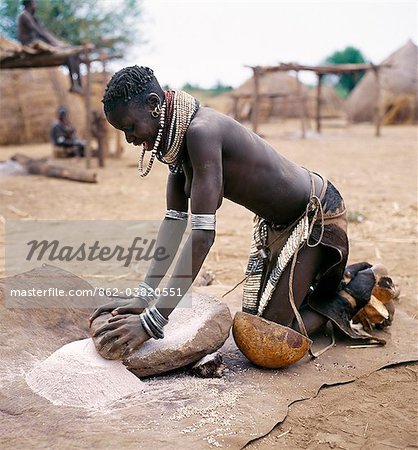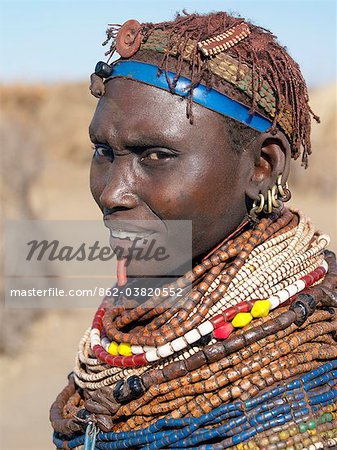
Nyangatom people from Omo valley, Ethiopia
Numerically small and bellicose, they tend herds in a particularly inhospitable part of the disputed Ilemi Triangle. The Nyangatom are some of the most feared warriors in the Omo Valley, locked in bloody feuds with the tribes that surround them.

Nyangatom boy with his facial tribal marks
The Nyangatom have grown in recent years. One estimate suggests the tribe’s numbers have almost tripled over the last three decades to about 14,000, partly due to the activities of Swedish missionaries who provided health care and relief supplies until they left in 2002.

Nyangatom girl Ethiopia Nyangatom girl Ethiopia — Fotopedia Eric Lafforgue
The Nyangatom are linguistically and ethnically closely related to the Toposa. A century ago, both tribes were known as ''Hum'' or ''Kum''. A name that still survives is '' Bume'' - the Ethiopian name of the Nyangatom. They are called by the pejorative exonym Bume meaning "the smelly ones" by their neighbours (all but one ethnic group in the region being their enemies) such as the Suri and Turkana in the Omo valley.

Nyangatom (Bumi) tribe boy from Omo River area , Omerate in Ethiopia with his traditional wooden cow-milk flask on his way from the pastures to the house.
Considered Ethiopians since the conquest of the Lower Omo Valley by Emperor Menilek II, the Nyangatom can be equally qualified as Sudanese because their territory straddles the border. They inhabit the south-western corner of Ethiopia, the Lower Omo Valley, but use the Ilemi Triangle on the south-eastern corner of Eastern Equatoria as a seasonal pastureland.

Nyangatom people singing and jump-dancing at Omo Valley, Ethiopia
The Nyangatom are famous among the tribes for their storytelling and singing. The favourite animals of the young men of the tribe are called song cows and song bulls; in ceremonies and during fights with neighbouring tribes, the tribe sing about them. You can hear these cattle songs sung by children round the village and they're picked up and copied by other groups throughout the region.

Nyangatom woman from Omo Valley, Ethiopia
The Name Nyangtom
In the course of their early migration from Uganda, the pastoral ancestors of the Nyangatom had been scorned as ''Elephant-eaters'' (Nyam-etom), a nickname which they aptly transformed into ''Yellow Guns'' (Nyang-atom) or literally 'revenge"; it underlined the martial intentions of their emerging community.

Ethnic Nyangatom people from South Sudan
Environment, Economic Activities and Natural Resources
At the end of the rainy season, some Nyangatom families prefer to stay with their Toposa friends rather than to return to their Ethiopian base. In the Toposa villages north of Kapoeta, especially among the Peymong section, one meets well established Nyangatom families with zebu cattle, sheep and goats, donkeys, wives and children.

Nyangatom people singing in their Omo Valley territory
Ecologically, the Lower Omo Valley is an extension of Lake Turkana depression and Ilemi Triangle shelters a prehistoric overflow channel of the lake towards the Lotilla river in the Murle country that extends from here to the White Nile basin.
The climate of the whole area is hot with low rainfall. The Nyangatom and their neighbours are semi-nomadic agro-pastoralists. They live on sorghum, maize, soja beans and tobacco cultivation, but their cultural preference is zebu cattle and small stock raising. They also keep donkeys for their migrations between Ethiopia and the Sudan.

Two Nyagatom girls wearing eye-catching tribal decorated leather skirts outside their family home ready for a singing festivities, Omo Valley, Ethiopia
In the Lower Omo Valley, the Nyangatom have two types of settlements. Since early times the part of the tribe which, for various reasons had lost its domestic stock, used to dwell in villages along the western bank of the Omo river, living on fish and sorghum cultivation.
Domestic animals cannot survive along the Omo because of the tse-tse fly. Families who manage to rebuild a herd commit it to their relatives’ care on the western part of Nyangatom territory, from the Kibish area on the Sudanese border to the western pasturelands of the Ilemi Triangle and the Toposa rangelands.

Nyangatom warrior with his gun
Language
The Nyangatom speak one of the Eastern Nilotic languages (nyangatom) which is closely related to Karimojong, and Iteso of Uganda, Toposa, Bahiima of Rwanda and Western Uganda and Turkana. These languages together form the cluster of (Hamitic people) Teso-Turkana languages.

Nyangatom people singing and doing their traditional jump-dancing
History
The Omo Valley is a patchwork of many different ethnic groups. The Nyangatom are part of a larger group, the Karimojong cluster, which is spread over four countries : Uganda (Karimojong, Jie and Dodos), Kenya (Turkana), Sudan (Toposa and Jiye) and Ethiopia (Nyangatom).

Nyangatom people singing at an occasion
Ethno-history suggests that the Nyangatom are rather recent incomers (mid-19th Century) into the Lower Omo Valley, as a result of a late-18th Century migration from the Koten-Magos area in Karamoja, Uganda, which brought the Nyangatom and the Sudanese Toposa to their present locations.
The Lower Omo Valley is a cultural melting pot: two of the four African major linguistic families are represented in the area: Nilo-Saharan (Nyangatom, Turkana, Mursi); Afro-Asiatic, with its Omotic (Karo, Hamar) and Cushitic branches (Dassanetch).

Nyangatom woman
Early travellers like von Höhnel and Teleki - who were the first Europeans to see Lake Turkana (initially named Lake Rudolph) in 1888 - considered the Omo villagers and the pastoralists on the West as two different tribes, naming the first ''Buma'' and the second ''Donyiro''. In fact they are one people. Ethiopians call them Bume to this day, while Dongiro, meaning ''people of the grey ox'' is still used in Uganda and Kenya in reference to the far away Nyangatom.

Nyangatom people at a playgrounds
Neighbours, Foreign Relations and Co-operation
Nyangatom and Toposa consider one another as ''Grand-mother’s thigh'' thus refraining from fighting to live in a system of mutual assistance. When an ox or a goat is killed a hind quarter of the animal is offered to the members of the other tribe residing in the neighbourhood.

Nyangatom woman
If the Nyangatom and the Toposa are allies, both groups face common, permanent or potential, ennemies. While on transhumance in the Ilemi Triangle, the Nyangatom fear, on their southern flank, Turkana raids, while to their north they consider the Suri and Baale, known as Kachipo in the Sudan, as irreducible foes.
Since the 1990''s the Nyangatom, armed with automatic guns, managed to push the Suri far away to the north. It is in this movement that they established, together with the Toposa, an important pastoral and military settlement on the foot of Mount Naita, on traditional Suri territory on and around the Ethio-Sudanese border.

Nyangatom young girls and the typical beaded back piece of their skirts. The land of the Nyangatom is traditionally around Mount Naita, so they live just north of the disputed Ilemi triangle, currently held by Kenya in both South Sudan and Ethiopia. | ©World Discoverer
The same situation prevails in the Lower Omo Valley, where proximate neighbours are potential enemies. Thus, the Nyangatom have conflicts with the Mursi to the North, the Dassanetch to the South, the Karo and the Hamar to the East. Fortunately the chronical state of intergroup raiding is mitigated by strong ties of personal friendship between members of communities which are, economically and culturally, complementary rather than opposed groups.

Nyangatom girl
Culture, Arts, Music and Handicraft
Like the Toposa toward the Larim and the Didinga, the Nyangatom are famous for their oratory gifts and their cattle songs are learned by neighbours of other language families. Reciprocally, the Nyangatom appreciate and acquire pots from Mursi and Karo women because their own wives have not mastered the skill of pottery.

Nyangatom woman with awesome hair-do, carrying her baby on her back. Murle region, Ethiopia
The demography of the Nyangatom remains difficult to evaluate. They were less than 5,000 in the early 1970''s, when the present author started his study, but they might be over 14,000 (on the eve of the 21st Century).
The demographic expansion was connected with health and relief assistance dispensed for 30 years (1972-2002) by the Swedish Philadelphia Church Mission (SPCM). But such a lasting assistance might have enhanced the dependency of a people living in an area of scarce resources. The NGO’s withdrawal from the area was deeply felt by the population.

Ethnic Nyangatom women
Society, Social Events and Traditions
The Nyangatom share with other peoples of the Karimojong cluster the main features of their social organization. They are divided into about 20 patrilineal descent groups or clans (sing.ateker, pl. ngatekerea), half of them being well attested in the rest of the cluster. The size of such clans varies from several hundred to a few individuals. The clans are no political units. Territorial sections (singl. ekitala, pl. ngiteala) are given names of migratory birds such as storks, flamingos, ibises, but also ethnic (Kumam, Ngaric) or common names (Castor trees), such sections have no fixed boundaries, but they express the relative positions of the settlements and reflect the nomadic routines of their members.

Nyangatom (Bumi) men scar/mark their faces and wear multicoloured decorations made from clay which are often adorned with feathers | Image scanned from the publication "Decorated Skin, a world survey of body art" by Karl Gornin.
The main originality of Nyangatom society is a generation-set (sing. auriunet, pl. ngauriuneta) system which, embracing men and women alike, allowed the Nyangatom to separate from their parent stock, which included the Toposa, and to become an autonomous polity. The males of one generation -- in the origin just those of the age-set (sing.anayamet, pl.nganyameta) of the Founders of the new independent polity -- procreate all the members of the generation to come, that of their sons, who procreate their own sons, and so on.
Each generation is given a social identity through the name of an Aristotelician species. Thus, Nyangatom ethno-history is recording the founders, their sons the wild dogs, then the zebras, the tortoises, the mountains (extinct generations), then the elephants, the ostriches, the antelopes, the buffaloes (living generations). In the year 2000, date of the author’s last visit in the field, the name of the children of the buffaloes was yet unknown.

Nyangatom (Donyiro) man showing his crocodile-like tribal beautification marks
Any generation is given one of only two status : their members, whatever their age, are considered to be either the Fathers or the Sons of the Country. Alternate generations, that is grandfathers and grandchildren, share a common status. In the daily routine, Fathers and sons sit under separate trees. The sons slaughter oxen in feasts dedicated to feeding their fathers. This is the first stage of initiation.

Nyangatom man with his beautification bumps
The second stage, the transmission of sovereignty from the Fathers to the Sons of the Country, is due only once in 50 to 55 years. It requires a hardly veiled human sacrifice : after the ceremony, the asapan-man, medium of the regeneration of the society, looses, like his generation-mates, his status of Father, but he also looses his mind, so that his fate is to perish in the bush. This custom, recorded among the sole Nyangatom, is an unexampled paradigm of the regicide documented for other Nilotes, e. g. the Shilluk, the Anyuak and others. The asapan ceremony was outlawed under Mengistu’s regime (also known as the Deurg or the reign, from 1974 to 1991, of the « Red Emperor »). The Nyangatom today are paving their way to modernity through their adhesion to Pentecostism.
Nyangatom men bathing in a river
They are indeed fierce warriors which is supposedly demonstrated by their custom to scar/mark their chest; one scar for each killed enemy. Heavy necklaces and long skirts from goat skins, which are richly decorated, are characteristic for the women.

Nyangatom woman from Omo Valley, Ethiopia
Necklaces were traditionally made from dry seeds, but these days they have been largely replaced with colourful glass beads coming from Kenya. The women also decorate themselves with ornamental scarification on their faces, chests, and bellies. Traditionally, until recently, the men were completely naked – just as the better known Surma and Mursi.

Beautiful Nyangatom woman
But lately they adopted a large piece of cloth, which they usually wear tied across the shoulder or wrapped around their hips, or even shorts and shirts. Also famous are the unique deep wells which the Nyangatom people must dig in dry riverbeds during dry season in the villages far from the Omo river.

Nyangatom tribal beautification marks
For their political and economic integration, they balance between two options : the Ethiopian, with the regional community of the « Southern Nations, Nationalities and Peoples », around the town of Jinka ; and the Sudanese, with the membership, which they share with the Toposa, of the Naita community which seems to be very much SPLA oriented. Not surprinsingly, as many other peoples living on border areas, the Nyangatom and their Toposa allies try to take advantage of their ambiguous, and too often uncomfortable, situation.

Nyangatom mother and kids
source:http://www.gurtong.net/Peoples/PeoplesProfiles/Nyangatom/tabid/224/Default.aspx
http://www.bbc.co.uk/tribe/tribes/nyangatom/
http://eye4ethnic.blogspot.com/2013_08_01_archive.html


Bumi man with his body painting








Nyangatom girl
_jpg_640x420_q85_ctf.jpg)







Nyangatom woman wearing numerous strands of beads made from wood. Omo River, southwest Ethiopia | ©Nigel Pavitt

Nyangatom tummy beautification mark



















0 comments:
Post a Comment